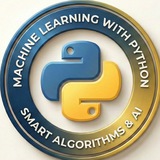80 Python Interview Questions.pdf
410.4 KB
- Covers frequently asked questions in Python interviews
#Python #DataScience #Programming #InterviewPrep #Coding #PythonInterview #TechInterview #DataScientist #PythonProgramming #LearnPython #CodeNewbie #CareerGrowth #TechJobs #PythonCode #PythonTips
https://t.iss.one/CodeProgrammer
Please open Telegram to view this post
VIEW IN TELEGRAM
❤13👍5
Forwarded from PyData Careers
1. What is the output of the following code?
2. Which of the following is NOT a valid way to create a dictionary in Python?
A)
B)
C)
D)
3. Write a function that takes a list of integers and returns a new list containing only even numbers.
4. What will be printed by this code?
5. What is the purpose of the
6. Which built-in function can be used to remove duplicates from a list while preserving order?
7. Explain the difference between
8. What does the
9. Write a generator function that yields Fibonacci numbers up to a given limit.
10. What is the output of this code?
11. Which of the following is true about Python’s GIL (Global Interpreter Lock)?
A) It allows multiple threads to execute Python bytecode simultaneously.
B) It prevents race conditions in multithreaded programs.
C) It limits CPU-bound multi-threaded performance.
D) It is disabled in PyPy.
12. How would you implement a context manager using a class?
13. What is the result of
14. Write a recursive function to calculate the factorial of a number.
15. What is the difference between
16. Explain how Python handles memory management for objects.
17. What is the output of this code?
18. Describe the use of
19. Write a program that reads a text file and counts the frequency of each word.
20. What is monkey patching in Python and when might it be useful?
#Python #AdvancedPython #ProgrammingTest #CodingChallenge #PythonInterview #PythonDeveloper #CodeQuiz #HighLevelPython #LearnPython #PythonSkills #PythonExpert
By: @DataScienceQ 🚀
x = [1, 2, 3]
y = x
y[0] = 4
print(x)
2. Which of the following is NOT a valid way to create a dictionary in Python?
A)
dict(a=1, b=2) B)
{a: 1, b: 2} C)
dict([('a', 1), ('b', 2)]) D)
{1: 'a', 2: 'b'}3. Write a function that takes a list of integers and returns a new list containing only even numbers.
4. What will be printed by this code?
def func(a, b=[]):
b.append(a)
return b
print(func(1))
print(func(2))
5. What is the purpose of the
__slots__ attribute in a Python class?6. Which built-in function can be used to remove duplicates from a list while preserving order?
7. Explain the difference between
map(), filter(), and reduce() with examples.8. What does the
@staticmethod decorator do in Python?9. Write a generator function that yields Fibonacci numbers up to a given limit.
10. What is the output of this code?
import copy
a = [1, 2, [3, 4]]
b = copy.deepcopy(a)
b[2][0] = 5
print(a[2][0])
11. Which of the following is true about Python’s GIL (Global Interpreter Lock)?
A) It allows multiple threads to execute Python bytecode simultaneously.
B) It prevents race conditions in multithreaded programs.
C) It limits CPU-bound multi-threaded performance.
D) It is disabled in PyPy.
12. How would you implement a context manager using a class?
13. What is the result of
bool([]) and why?14. Write a recursive function to calculate the factorial of a number.
15. What is the difference between
is and == in Python?16. Explain how Python handles memory management for objects.
17. What is the output of this code?
class A:
def __init__(self):
self.x = 1
class B(A):
def __init__(self):
super().__init__()
self.y = 2
obj = B()
print(hasattr(obj, 'x') and hasattr(obj, 'y'))
18. Describe the use of
*args and **kwargs in function definitions.19. Write a program that reads a text file and counts the frequency of each word.
20. What is monkey patching in Python and when might it be useful?
#Python #AdvancedPython #ProgrammingTest #CodingChallenge #PythonInterview #PythonDeveloper #CodeQuiz #HighLevelPython #LearnPython #PythonSkills #PythonExpert
By: @DataScienceQ 🚀
❤9
